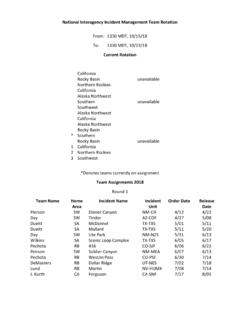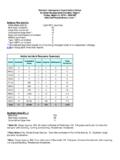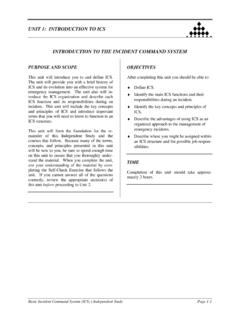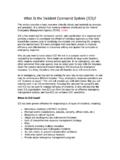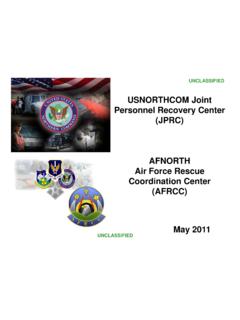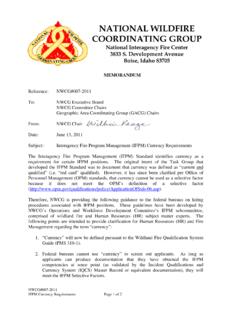Transcription of Strategic and Operational Plan - FEB
1 FEDERAL EXECUTIVE BOARDNATIONAL NETWORKE PLURIBUSUNUMS trategic and Operational plan 2018 - 2022 Federal executive Board NatioNal OCTOBER 2017A National Network with Local ConnectionsFEDERAL EXECUTIVE BOARD NETWORK Strategic and Operational plan FY2018-2022 INTRODUCTION The first 10 Federal Executive Boards (FEB) were established by Presidential Directive (Appendix A) in 1961 to increase the effectiveness and economy of Federal agencies by coordinating Government activities outside of Washington, DC. Currently, 28 FEBs are located nationwide in areas with a high concentration of Federal agencies and Federal employees (Appendix B). Each FEB represents an average of 140 agency components, depending upon its geographic area of responsibility, and is comprised of the highest ranking local Federal leaders.
2 Today, given that approximately 85% of Federal employees are located outside of the Washington, DC area, the Boards are more critical than ever. In continuing times of personnel reductions, budget cutbacks and reorganization, interagency collaboration is critical to achieving results. As the local Federal ambassadors, the Boards identify opportunities for partnerships with intergovernmental and community organizations. interagency collaboration is no longer just a wise choice; it is the effective and efficient approach to meet agency mission goals. The FEBs are models for partnership-based government. The Boards make intergovernmental and interagency coordination possible by identifying common ground and building cooperative relationships. FEBs also have a long history of establishing and maintaining valuable communication links among Federal agencies, greatly increasing their abilities to prepare for and respond to local and national emergencies. In their work to promote issues related to Administration initiatives, FEBs provide targeted training programs, employee development, shared resources, and local community outreach and participation.
3 The Boards role as a conduit of information and a meeting point for a variety of agencies each with a different mission is critical to a more effective Government. FEBs promote awareness of the Federal Government s involvement in, and contribution to, communities across the country. The Office of Personnel Management (OPM) is responsible for the organization and functions of FEBs (5 CFR Part 960; Appendix C). Under the direction and guidance of the OPM Director, the Boards function in four general areas: (1) Coordinating local approaches to national programs and shared management needs; (2) Providing a forum for the exchange of information between Washington, DC, and the field about programs, management methods and administrative issues; (3) Communicating from Washington, DC, to the field about management initiatives and other concerns for the improvement of coordination; and (4) Raising awareness at the national level of local issues with potential far reaching impacts.
4 The OPM National Program Office staff supports the Director to ensure effective program operations across the FEB Network. As interagency organizations, FEBs do not receive direct appropriations for their operations, relying on voluntary funding and staffing by departments and agencies. VISION To be catalysts for better Government. MISSION STATEMENT Increase the effectiveness of Federal Government by strengthening coordination of Government activities. GUIDING PRINCIPLES 1. Integrity 2. Service 3. Excellence Strategic GOALS The Federal Executive Boards will 1. Promote and deliver programs and services related to Emergency Preparedness, Employee Safety and Security. 2. Promote and deliver programs and services related to Workforce Development and Support. 3. Promote and deliver programs and services related to Strategic Partnerships. 4. Support the FEB Network by building the capacity of all FEBs and improving commonalities within the network s administrative functions.
5 Strategic & Operational Objectives Strategic Goal #1: Emergency Preparedness, Employee Safety and Security The Federal Government is the Nation s largest employer (and the first or second largest in many metropolitan areas). In times of emergency, we have a responsibility to collaborate in our communities. To that end, FEBs play a vital role. This Strategic Goal produces interagency communication, shared resources and workforce education. The goal is to create effective collaboration on emergency readiness and recovery, and to educate our Federal workforce on issues in emergency situations. FEB Network Emergency Preparedness Council The FEB Network Emergency Preparedness Council identifies, evaluates and distributes relevant information pertaining to this line of business for use by all FEBs. The FEB Network Emergency Preparedness Council supports Federal agencies throughout the country by sharing the resources, lessons learned and best practices of individual FEBs amongst the FEB Network.
6 The FEB Network Emergency Preparedness Council also serves as a liaison with OPM, the Federal Emergency Management Agency (FEMA), and other principals, and acts in an advisory capacity in the areas of FEB involvement in emergency readiness and response. The FEB Network Emergency Preparedness Council is comprised of up to seven FEB Executive Directors, affirmed by OPM, who each serve up to a three-year term. Upon completing the term on the FEB Network Emergency Preparedness Council, the FEB Executive Director will rotate to another FEB Network Council. FEB Executive Directors will serve on one FEB Network Council at a time. The FEB Network Emergency Preparedness Council will: 1. Identify the FEB role during a local emergency or incident of national significance. 2. Research and advise on potential improvements and standardized methods to maintain communications across the FEB Network. 3. Maintain an FEB backup system for on-demand communications that is uniform across the network at the regional and cross-network levels and provide standardized requirements for sharing of information.
7 Each Board will: Facilitate or engage, at a minimum, a quarterly Emergency Preparedness/Continuity Working Group per the Memorandum of Understanding between OPM, FEMA and the FEBs. Operate an All Hazards Emergency Notification and Advisory plan that includes: A protocol for emergency actions. An on demand database of contacts for agencies updated at least once annually. An on demand communications system tested at least once annually. Facilitate an interagency emergency planning event and/or one educational/training program annually. Provide guidance and assistance to members as appropriate. Disseminate information to/from headquarters establishments. Liaise with Federal, Tribal, State and local Government officials on emergency preparedness issues. Strategic Goal #2: Workforce Development and Support This Strategic goal facilitates strategies and approaches for recruiting, training, and retaining Federal employees, as well as sharing best practices and workforce education.
8 The goal is to provide accurate, timely and useful information throughout the FEB Network. FEB Network Workforce Development and Support Council The FEB Workforce Development and Support Council identifies and distributes information on Federal workforce programs for use by all FEBs. The Council supports Federal agencies throughout the country by sharing the best practices of individual Boards amongst the FEB Network. This information will be shared through FEB websites, monthly reports, and national meetings of FEB representatives. The Council is comprised of up to seven FEB Executive Directors, affirmed by OPM, who each serve up to a three-year term. Upon completing the term on the FEB Network Workforce Development and Support Council, the FEB Executive Director will rotate to another FEB Network Council. FEB Executive Directors will serve on one FEB N etwork Council at a time. The FEB Network Workforce Development and Support Council will: 1. Review and update, as appropriate the FEB Executive Director resource manual annually.
9 2. Advise on current cost-avoidance metrics for the training activities sponsored by the FEB Network. 3. Identify and share member (or Federal) Agencies best practices for recruitment, retention, and outplacement programs. 4. Develop and maintain an FEB resource training guide. 5. Increase awareness and access to virtual learning opportunities for the FEB Network. Each Board will: Sponsor at least two Workforce Development Best Practice Forums annually (in person, virtually, or on-demand). A forum is defined as a singular meeting, training, or recognition event. Examples include, but are not limited to: Employee Recognition Diversity/Veterans Leadership Employee Recruitment/Workforce Planning Work-Life Balance Job Fairs/Federal Career Days Sponsor at least two Education/Training Programs based on local needs annually in person, virtually, or on-demand. A program is defined as a planned series of recurring trainings. Examples include, but are not limited to: Rotation Programs Leadership Development Program (entry, mid-level, or Executive) Mentoring Programs Management Training Skill Development Retirement Planning Monitor Alternative Dispute Resolution (ADR)/Shared Neutral Program and complete an assessment to determine relative value of ADR services to member agencies annually, if applicable.
10 Provide guidance and respond to member agencies needs for recruitment, r etention, and succession planning assistance, as appropriate. Disseminate information to/from headquarters establishments. Liaise with Federal, Tribal, State, and local Government officials on workforce development and support issues, as appropriate. Strategic Goal #3: Strategic Partnerships This Strategic goal advances local and national initiatives through interagency collaboration and community outreach. FEBs serve as Federal ambassadors to represent agencies and their missions to State and local government, Congressional offices, and community organizations. The goal is to engage with local communities and to improve implementation of Governmentwide and agency initiatives through effective communication and collaboration. FEB Network Strategic Partnerships Council The FEB Strategic Partnerships Council serves as the primary resource for the FEB Network in matters related to collaboration and outreach.

